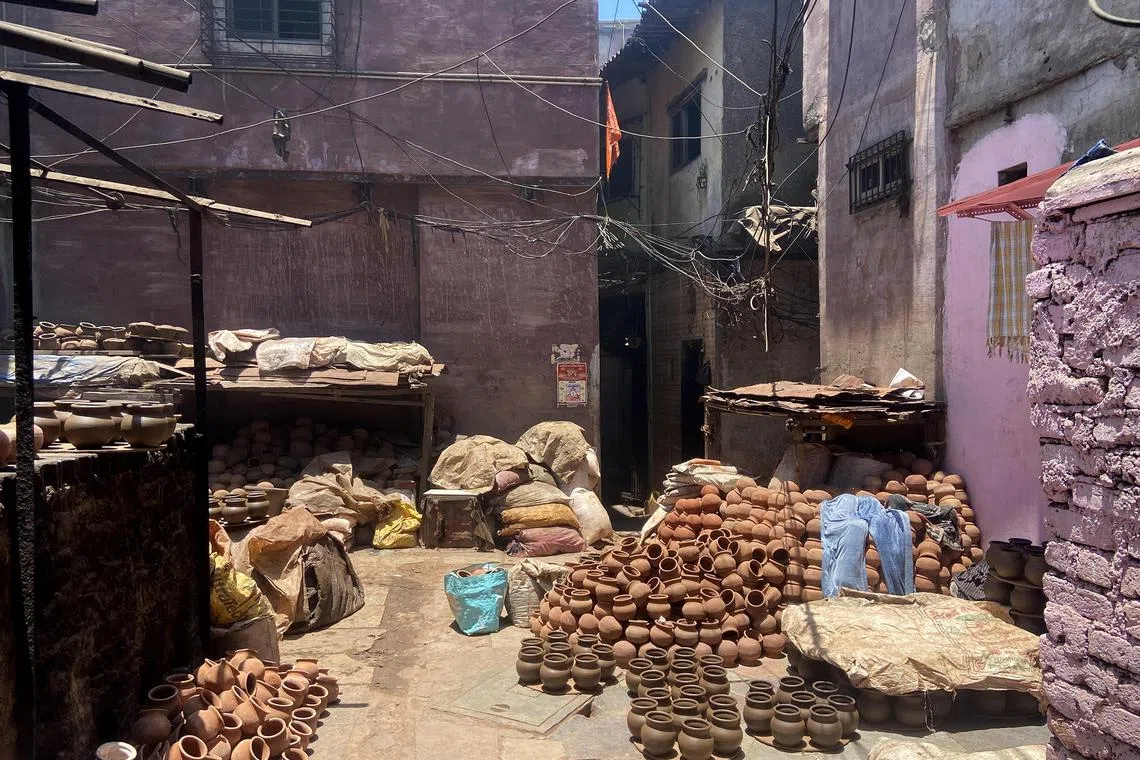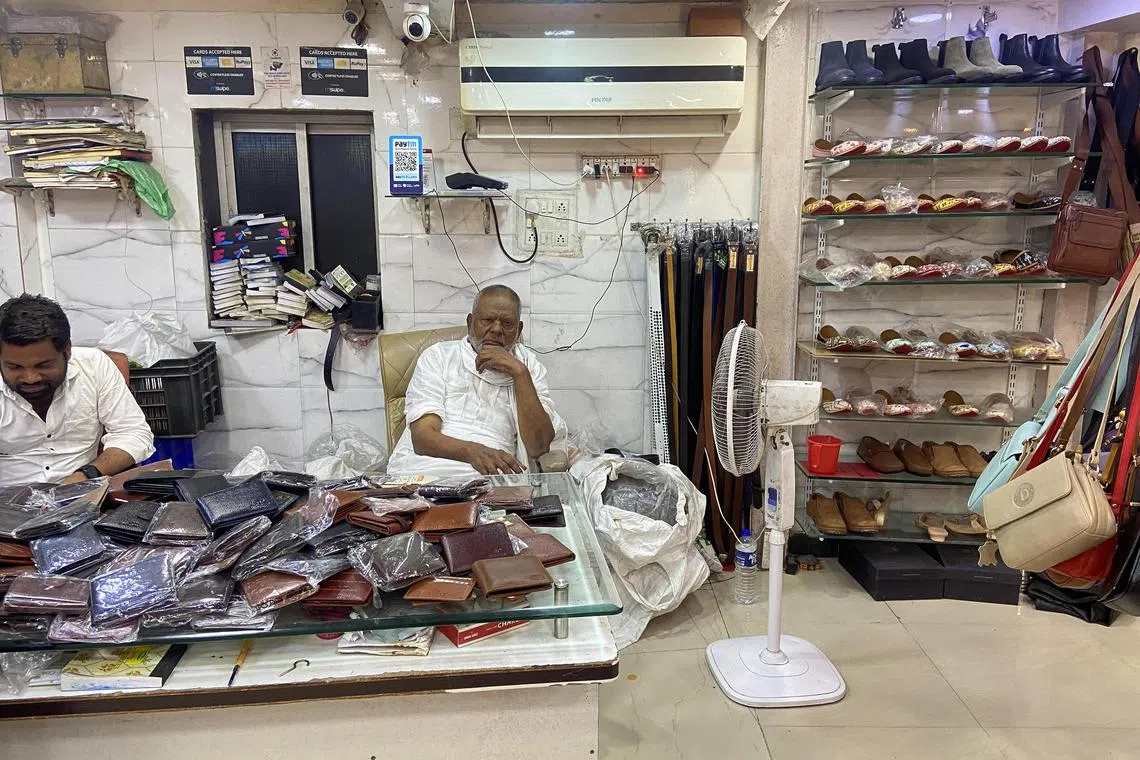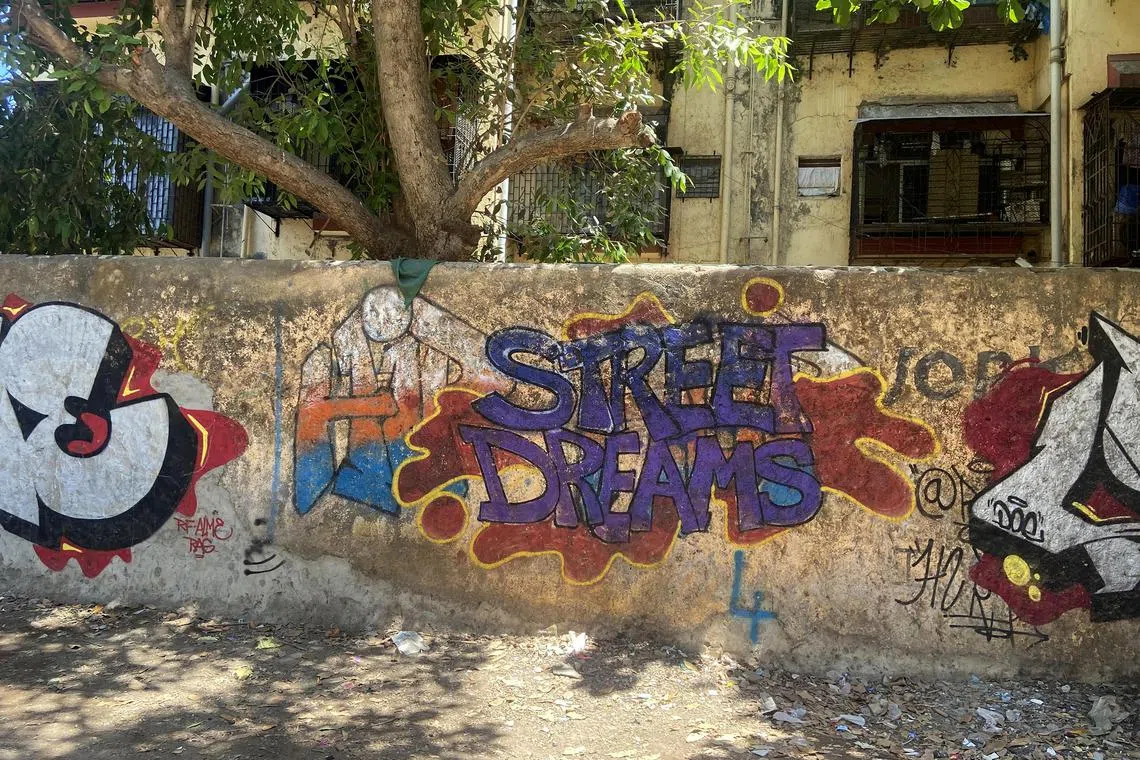As India’s biggest slum Dharavi gears up for extreme makeover, hope jostles with fear
Sign up now: Get insights on Asia's fast-moving developments
Follow topic:
MUMBAI – In Dharavi, India’s biggest slum, childcare centre worker Shobha Pravin Patil dreams of a kitchen with a refrigerator, clean water at the turn of a tap, a dining table for sit-down meals with her family and a proper bathroom all to themselves.
Here in the heart of Mumbai, the country’s largest city and its financial centre, Mrs Patil’s family of 10 live cheek by jowl in two cramped rooms, one on top of the other, joined by a rickety ladder.
In Dharavi, which is Asia’s second-biggest slum, more than a million people are packed into an area of around 239ha, or nearly three times the size of the Singapore Botanic Gardens.
Due to its unique characteristics, including an entrepreneurial spirit, many also prefer to call it an informal settlement rather than a slum.
The Patil family home – which has space only for the barest of necessities, including a stove with a small gas cylinder – opens out onto a maze of narrow alleys. Water for the residents’ daily needs is piped into large blue drums in each home, and communal bathrooms with one toilet each are shared by around 1,500 people.
“Sometimes, I can’t breathe. The lanes are so narrow. I dream of a bigger house,” said Mrs Patil, 42.
Families like hers are pinning their hopes on a seven-year plan by Indian billionaire Gautam Adani
In November 2022, Mr Adani’s company won the rights to redevelop Dharavi. The slum sits on prime property in Mumbai, which has among the highest real estate prices in the world.
But the redevelopment plans, which are still in a very initial phase, have already met with opposition from local businesses and residents who fear they will be moved out of Dharavi and lose their livelihoods as a result.
The award of the tender has also been caught up in the political crosshairs, with the opposition accusing the ruling state government of favouring the Adani Group, including in the award of development rights; a charge that the group has denied.
Among those uncertain about the redevelopment is 50-year-old Mr Hasmukh Jethwa, a fourth-generation potter, who is filled with trepidation at the coming changes and wonders if his traditional family business will survive the modernisation plans.

Pottery drying in the sun in Dharavi, located in the heart of Mumbai.
ST PHOTO: NIRMALA GANAPATHY
“Redevelopment should happen, but they have to safeguard our employment,” said Mr Jethwa, sitting at the entrance of his home while fashioning lumps of clay into small oil lamps.
His family of four live in a 182 sq ft room, while the courtyard area outside is considered public space that is utilised by him and neighbouring potters to dry and store their clay lamps.
Dharavi has an active informal economy where a myriad of small-scale enterprises flourish, including businesses involved in leather goods, garments, pottery, recycling and even poppadoms.
About 250,000, or one in four, residents in the slum are employed by these businesses, which generate an estimated US$1 billion (S$1.35 billion) in annual revenue.
Men balancing large, heavy sacks on their backs trudge up and down walkways as vehicles cannot enter many of the lanes.
Workers pack freshly baked biscuits to be supplied to bakeries and shops in Mumbai in one room, while in the next, tailors are busy stitching jeans for export.
A few lanes away, plastic car parts are broken down into plastic shards as part of the recycling business, with Dharavi recycling 80 per cent of Mumbai’s solid waste.
The owners of the small enterprises are worried about how the redevelopment plans will impact their livelihood.
“We don’t know if they will give us space for our businesses,” Mr Jethwa said.
Still, there is little doubt that Dharavi is in need of redevelopment, and that residents would welcome better living conditions.
Amid the many lanes criss-crossing the length and breadth of the vast slum, open drainage is visible in many parts amid the lingering smell of poor sanitation and piled-up garbage.
Massive queues at the communal toilets and limited supply from the shared water pipes are a fact of life, as is flooding during the monsoon season, with water entering homes in some parts of the slum.
However, the price of shelter is affordable by Mumbai standards: 7,000 rupees (S$113) a month for a tiny room in Dharavi versus 34,000 rupees for a 620 sq ft one-bedroom apartment in the nearby neighbourhood of Sion Koliwada.
While a firm plan has yet to be announced, a spokesperson for the Dharavi Redevelopment Project – a joint venture between Adani Realty and the Maharashtra state government – told The Straits Times some details had been finalised.
For one thing, Dharavi residents who have been living on the ground floor before Jan 1, 2011, will be offered new 350 sq ft apartments – with bedroom, living room, toilet and kitchen – and no maintenance fees for 10 years. The spokesperson added that this apartment size is 17 per cent bigger than that of other similar slum schemes in Mumbai.
The new development will also have train, metro and bus connectivity, as well as schools, hospitals, running water and sewage systems, said the spokesperson.
Those who live on the higher floors or become residents in the slum after the cut-off date will be offered 300 sq ft apartments within 10km of Dharavi.
Mr Wahaj Khan, who runs a family business selling leather products under the brand name Dharavi, is sceptical about the redevelopment plans.

Mr Wahaj Khan, who runs a family business in Dharavi selling leather products, is sceptical about the redevelopment plans for the slum.
ST PHOTO: NIRMALA GANAPATHY
A tanner by trade, Mr Khan said he came from Uttar Pradesh state with 100 rupees in his pocket to Dharavi four decades ago, and has built a thriving leather goods business that exports to Britain, the US and the Middle East.
“Developing Dharavi is no small matter. You give us enough compensation and we will take it. Otherwise, we will not,” he stressed, adding that he was not satisfied with the current compensation.
Critics of the redevelopment plan say the Adani Group is in it for the money since it would be building new apartments to sell on the open market, in exchange for the free housing and compensation to be given to eligible residents.
“The basic proposition is to give everyone free housing... at zero cost, with nothing to be paid for either construction or land, but with the freedom to resell at market rates,” said Mr Shirish Patel, a civil engineer and urban planner.
“The free rehab construction is a promise made in order to secure the present occupants’ consent. To pay for this free construction, plus walk away with a profit, enough of the Dharavi plot area has to be freed up to construct high-value luxury buildings for sale,” he added.
“No promises have been made as to how livelihoods will be maintained,” Mr Patel said.
Adani Realty is in the midst of conducting a survey of Dharavi’s residents to identify who is eligible for what compensation.
According to the project spokesperson, the nine-month survey, due to be completed by December, will cover “all residents of Dharavi, all commercial and other establishments including religious structures”.

Street art in Dharavi, India’s biggest slum.
ST PHOTO: NIRMALA GANAPATHY
The residents’ concerns about their livelihood and plans for skills training will also be addressed.
This is not the first attempt to redevelop Dharavi. In 2003, the Maharashtra state government wanted to transform Dharavi into an integrated township. But its plans drew protests from residents concerned about the size and quality of homes being offered in the redevelopment programme.
The idea floundered, and after several false starts over the decades, Adani Realty secured the project with its bid in 2022.
While Mr Adani will get to develop a veritable real estate gold mine in the centre of Mumbai, he will also face challenges redeveloping a huge, heavily concentrated area. Dharavi’s population density is more than 15 times that of the rest of the city.
In response to criticism that the Dharavi project is yet another money-making scheme for the multinational conglomerate, Mr Adani, who is from Gujarat state, said he wants to “build a new Dharavi with respect, security and inclusiveness”. He described Mumbai as his second home when he arrived in the 1970s and got into the diamond trade.
Since then, Mr Adani, who is now the second-richest Indian, according to Forbes, has grown his business interests in various sectors, including ports, real estate and energy, with its meteoric rise grabbing international attention. In January 2023, US short-seller Hindenburg Research accused the Adani Group of stock manipulation and improper use of tax havens, a charge refuted by the group.
“Of all the work being done by our group, Dharavi is closest to my heart,” Mr Adani said in a March 19 press statement.
Still, Dharavi residents continue to dream of a better future, moving from dilapidated tenements to clean, modern homes.
One of them is Mr Janardhan Poojari, a tour guide, who moved to Dharavi a decade ago from his village in southern Karnataka state.
“In the beginning, it was tough because I have never been in any slum before. In the village, we had more, clean space. The monsoon was the toughest time because through open drainage, rats come inside the house sometimes,” he said.
He has since become used to living in the slum and splits the 10,000 rupee monthly rent with a roommate.
“I don’t mind if they redevelop Dharavi. It will make many people’s lives better. We are struggling because of poor sanitation and drainage.”
Mrs Patil, who is confident she will be eligible for a new home in a new Dharavi, said: “My mother-in-law kept dreaming about redevelopment, but she passed away... before anything happened.”
With redevelopment long overdue, Mrs Patil is hoping to see it happen in her lifetime.


